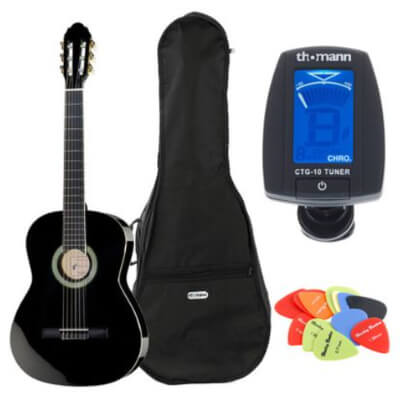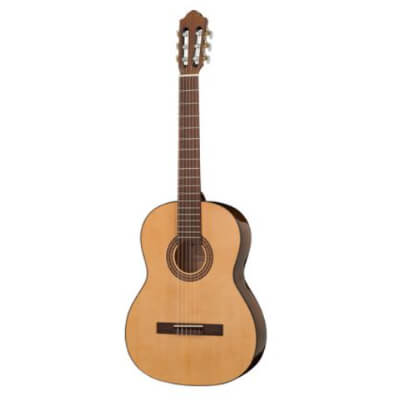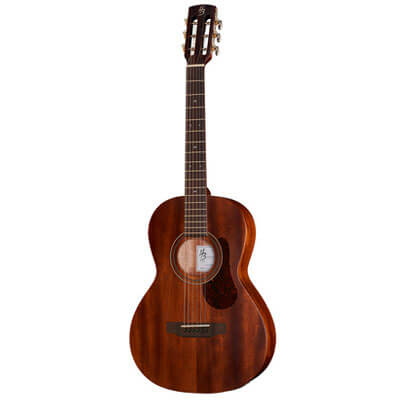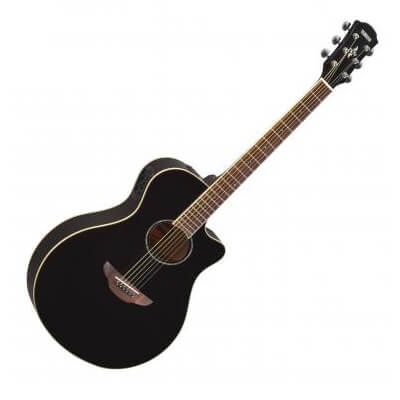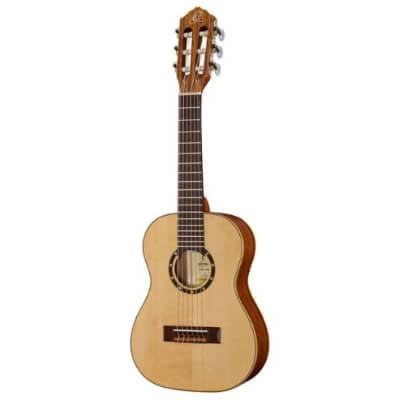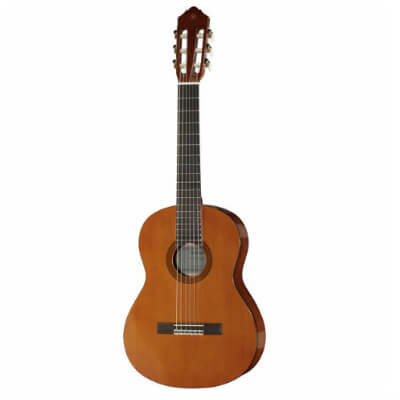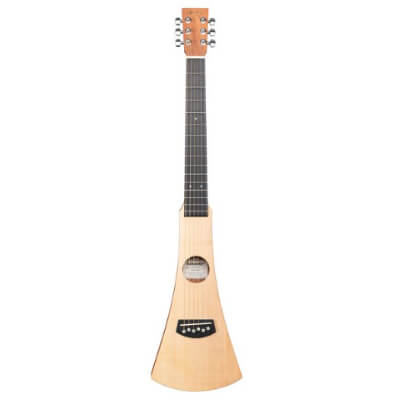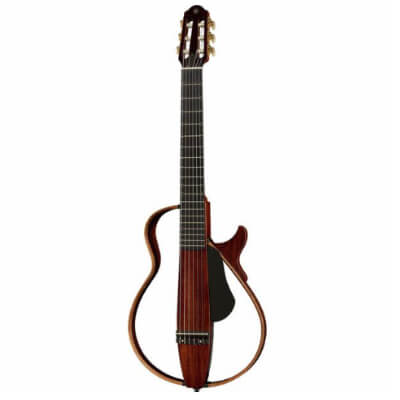Buying a guitar: My 8 best recommendations 2025
Here you will find my recommendation for the best guitars for beginners, advanced players and kids. Before you spend a lot of money on it, you should read up on the subject (see frequently asked questions). Then you will enjoy your guitar for many years!
This text has been translated into English. Please report spelling mistakes to sebastian@musiksocke.com
What kind of guitar are you looking for?
Frequently asked questions:
Guitar for beginners
Classical guitars are best for beginners. The necks of these guitars are wider than those of an acoustic guitar. This makes it easier for beginners, in particular, to grip the guitar cleanly. In addition, nylon strings are used on these instruments. They are easier on the fingertips and have a lower basic tension than steel strings, which makes playing easier.
Since every guitar is an extremely demanding instrument in terms of craftsmanship, one should pay attention to good playability right from the start. Not only does it have to sound good, it also has to be fretless, the strings should not be too high or too tight on the neck, and the tuners have to reliably keep in tune.
The Harley Benton CG200-BK set is a set with a good classical guitar for beginners. A bag, tuner and picks are included. Unfortunately, a capo is not included. The guitar is surprisingly good for the price, but you notice the cheap workmanship. It needs to be retuned frequently. I think that the set is perfectly adequate for beginners.
The Thomann Classica S 4/4 classical guitar is a reliable entry-level model with a good price-performance ratio. In my opinion, you can’t get a better guitar in the price segment under 200 euros. It is neatly finished and has a low string action. The sound is pleasant and sounds like a typical concert guitar. I know some music schools that give their students the Classica S as their first guitar.
Guitar for advanced players
For guitar players, the acoustic guitar is the next step after the classical model. When it comes to the shape of the body, the bar system and the often highly decorative inlays, almost all manufacturers still follow the designs of Christian Frederick Martin from the mid-19th century. Another well-known designer was Orville Gibson, who also made the first guitars with arched tops in the 19th century. With acoustic guitars, stronger steel strings are used instead of nylon strings.
A big difference to the classical guitar is the fingerboard of the acoustic guitar. It is narrower, so that you can also use the thumb of your fingering hand when playing. While the fingerboard of a classical guitar measures about 5 cm at the nut, it is usually only 4.3 cm wide on an acoustic guitar. Exceptions are the guitars for fingerstyle artists. Here the fingerboards are about 4.6 cm wide. The fingerboard is fitted with inlays. These inlays help with orientation and are usually found at the 3rd, 5th, 7th, 9th, 12th, 15th and 17th frets. The neck of an acoustic guitar contains a steel rod, which on the one hand provides more stability and on the other hand makes it possible to change the curvature of the neck.
The Harley Benton Custom Line CLP-15ME is an acoustic guitar with pickup. It has a slightly smaller body and a shorter scale length. The workmanship is very good, resulting in a nice compact acoustic guitar. The sound is more midrange-oriented, the bass is weaker. Ideal for acoustic pieces. The pickup gives a clean sound. The price is absolutely fair for this quality. My personal favourite among the acoustic guitars.
The Yamaha APX 600 Black is a good acoustic guitar for all styles from country to blues. The sound is very good, both acoustically and electronically. I would describe the sound as balanced. Due to the slightly narrower fingerboard, people with small hands can also grip the guitar well. The pickup does its job without any problems and produces a rich sound even with small PA systems. All in all, a good acoustic guitar with a fair price-performance ratio.
Guitar for kids
Classical guitars of the right size and with nylon strings are especially recommended for kids, as steel strings can cut too much into the fingertips. In addition, they learn an exact fingering technique with a classical guitar. But it is also easier to switch from a classical to an acoustic or electric guitar than the other way around.
The European Guitar Teachers Association recommends exact measurements of the scale length (from bridge to nut) for every body size.
A children’s guitar is also a fully-fledged instrument. As a guideline, you can assume that any guitar under 50 euros can only be a toy, but not a musical instrument.
The Ortega R121 is one of the best-selling concert guitars and is available in many different sizes. There are also models for left-handers. It is solidly built and has not shown any weaknesses in its workmanship. A good guitar for beginners with a warm sound. The strings included are okay and can be played well by children’s hands. Visually, I think it is very chic, as it looks like a typical classical guitar. A good introduction to the world of stringed instruments for kids.
The Yamaha CGS 102 1/2 Classical Guitar Set includes a good guitar and all the essentials to get you started. The set includes picks, spare strings, pitch pipe, backpack and a simple practice book. The accessories are rather average, but sufficient for a start. However, the guitar is perfectly fine for the price. Even the small models produce a clean and full sound. The workmanship is consistently good. I know some music schools that recommend the kids sizes from Yamaha, as they are good classical guitars at a reasonable price.
Guitar for crazy people
The guitar is a very popular instrument, so there are also some strange models. If you are crazy about guitars in the positive sense, you can expand your collection with these special instruments:
The Martin Guitars Steel String Backpacker Guitar is an acoustic guitar that falls into the category of “travel instrument”. With its unusual shape, you save space and can take the guitar with you on long journeys. A matching bag is included. As you would expect from Martin Guitars, this is a fully-fledged instrument with a high-quality finish. You can really make music on it!
The Yamaha SLG200NW NA is a very special classical guitar. Due to the unusual design, the guitar is significantly quieter than classical instruments. The back and lid have been omitted, which makes the guitar ideal for practising and recording in quiet environments. However, the feeling when playing is somewhat different and you have to get used to it.
How do I recognize a good guitar?
First of all, before buying a guitar, the instrument should be checked for manufacturing defects. Attachments, such as the bridge on a guitar, must be well glued on. The transition from body to neck must also be checked carefully. Screwed necks must lie firmly in the neck pocket and glued necks should be perfectly and neatly aligned.
The condition of the surface gives a first impression of how conscientiously the instrument has been made. If there are any faults in the varnish or if there are impurities in the general condition of the woods, you should look for another instrument. If the instrument has a high price, there should be no faults in the varnish or in the flatness of the woods.
Without question, a good factory setting is crucial. The guitar should be set up ready to play right from the start. This also includes the condition of the frets. If the frets have not been polished cleanly, a clean grip and fast gliding over the frets can be made almost impossible. In addition, the frets must be of a uniform height and must never protrude beyond the edges of the fingerboard.
Another point is intonation. This is done by comparing the tone at the twelfth fret on each side as a harmonics (here the string is not pressed down but only touched lightly above the twelfth fret bar) and as a fretted tone. If deviations occur, the guitar must be readjusted. On high-quality instruments, these differences should not occur ex works. However, you should never buy a guitar on which the frets are not placed exactly in the right position on the fingerboard.
The sound and the whole potential of a guitar is largely determined by the type of wood used. Basically, it can be said that the entire body of a guitar must be covered by a solid top. The vibration characteristics are determined by this top. Of course, it is even better if the entire instrument is made of solid wood. Whether one prefers spruce or cedar depends on personal taste. Here, too, you should test from a wider selection.
Different types of wood have become established for electric guitars. Ash and alder are used for instruments that are supposed to have a tangy sound. Instruments with a richer sound are usually made of mahogany. The fingerboards are usually made of maple, mahogany or rosewood. If the guitar is made of these woods, it is a sign that you are on the right track. For some time now, excellent guitars made of graphite have also been on the market. Here, too, it is important to test such an instrument carefully. Which woods may be used for instrument making is regulated by the CITES Convention on International Trade in Endangered Species.
Let us now turn to the vibration characteristics. Here you have to prick up your ears and listen to how the individual notes and chords sound. Are there notes that drown out or dominate in the interplay of all the strings? Do the strings resonate evenly or does one note remain behind? How does the instrument react when played very sensitively and how hard can it be struck or plucked? If you are still inexperienced, you should consult an experienced player.
Last but not least, the hardware of every guitar must meet all requirements. In addition to the nut and bridge, this also includes the tuners, which must remain reliably in position and not wobble.
What accessories do I need?
Depending on the guitar model, different strings should be used. Basically, acoustic and electric guitars should only be fitted with steel strings and classical guitars with nylon strings. Everything else is often a matter of taste and experience. Spare strings should always be close at hand. You never know when a string will break. A classic among musicians is the D’Addario EJ45 string set for the classical guitar. I always have a pack of these at home.
Picks help you play and are easy on your fingers. To find out which pick suits you best, we recommend ordering a set with different thicknesses. Then you can try out all the picks at your leisure and then buy more. The Dunlop Acoustic Pick Variety Pack is ideal for this. 12 different picks invite you to try them out.
For beginners, a good tuner is important. Professionals can tell from the sound which string still needs to be tuned. But to get started, you should not do without electronic help. Chromatic tuners are a great time-saver. These devices analyse the pitches of all strings and then indicate which strings need to be tuned and how. I use the TC Electronic PolyTune Clip Tuner. It is precise and easy to use even for beginners. It’s worth it!
With a guitar stand, you can safely store your instrument. I have tried different stands over the years and find the simple models the best. This one is the Millenium GS-2001 A. My guitar is stable and the thick rubber coating protects the instrument.
You can use special wall mounts for your guitar. I have a spare guitar hanging on the wall. It’s not used that often and can be used as a decoration in my flat. If you have several guitars, you can decorate the whole wall with them. I have the Hercules Stands GSP-39WB+ and am satisfied with it. The wall mount has an auto-grip system and encloses the guitar securely. It also works for heavy guitars. I have no worries about anything happening to the guitar.
For transport, you have the choice between bags and cases. The case protects the instrument a little better, but well-padded bags are also sufficient for short transport. I find a guitar bag more practical and have the Thomann gig bag for acoustic guitars. Make sure that your guitar fits in it. With internal dimensions of 111 x 42 x 13 cm (LxWxD), all standard guitars fit in the bag.
Capos make it easier to play in different pitches without having to use completely different finger positions, which can result in a different sound. There are many different designs and it is a subjective decision which model you like best. Many musicians use a Harley Benton capo, which can be bought for little money in a simple version. A good model is the Harley Benton HBCA-K Acoustic/Electric Capo.
Classical guitarists are often seen using footrests that offer them a safe and comfortable playing position. Otherwise, if you play the guitar for a long time, you will get back or neck pain if you adopt the wrong posture. For starters, the K&M 14670 footrest is perfectly adequate. With 6 ratchet steps, the right height can be comfortably adjusted.
Many guitarists use straps to carry their guitar comfortably around the shoulder. Here, it’s mainly the look that matters. The only important thing is that the straps are adjustable. I find a plain guitar strap the most beautiful. The Fender Supersoft Strap Black looks good and is comfortable.
Learning the guitar is easy with the right textbook. If you practise regularly, you will soon see success. There are countless apps and online courses, but I think a normal book is the best way to learn. Let’s Play Guitar is recommended for beginners. It explains the most important basics and is also a songbook with 40 well-known songs.
Further accessories are thumb and finger picks, bottlenecks made of steel or plexiglass for blues and rock, care products and tools. However, the accessories described here are sufficient for a start. As your enthusiasm grows, you can try out more.
What are the best guitar brands?
In this list you will find all established and experienced guitar brands. In recent years, they have been able to convince with high-quality workmanship and great-sounding instruments.
How much does a good guitar cost?
A good guitar costs between 200 and 500 euros. For beginners, however, cheaper models in the price category of 100 to 200 euros are also interesting.
You should keep your hands off new guitars for less than 100 euros because these are cheap products that are usually poorly made. I have held inexpensive guitars in my hands that broke when I tried to wind the strings!
As soon as playing the guitar has become a regular hobby, it is advisable to change to an advanced guitar. You will notice the better workmanship and produce a cleaner sound when playing.
More information about good guitars.
What is the best guitar for beginners?
The best guitar for beginners is the Harley Benton CG200 for about 70 euros. The set includes a good classical guitar and all the necessary accessories. Good strings are strung at the factory. So beginners can start practising right away. In my opinion, this is sufficient for the beginning.
The next step is to buy a higher quality guitar for advanced players. These models range in price from 200 to 500 euros. With the right strings, you can get a better sound. It might also be worth switching to an acoustic guitar or an electric guitar.
I have summarised more details for beginners here.
⚠️
* For the links marked with a star, we receive a commission on a purchase. The price does not change for you. Please use our link and support the independent work of Musiksocke. Thank you very much!
✔️
The product recommendations made here are based on my experience and conversations with expert musicians. All products presented here meet the criteria of the checklist.
🏦
All prices are incl. VAT plus shipping costs. The amount was estimated by me and may differ from the actual price. As an Amazon partner, I earn on qualified sales. This also applies to Thomann, Kirstein and all other partners.
String instruments:
Wind instruments:
Key instruments:
Drums:
Recording:


